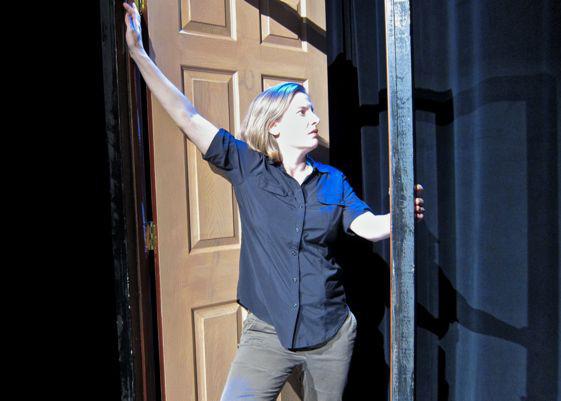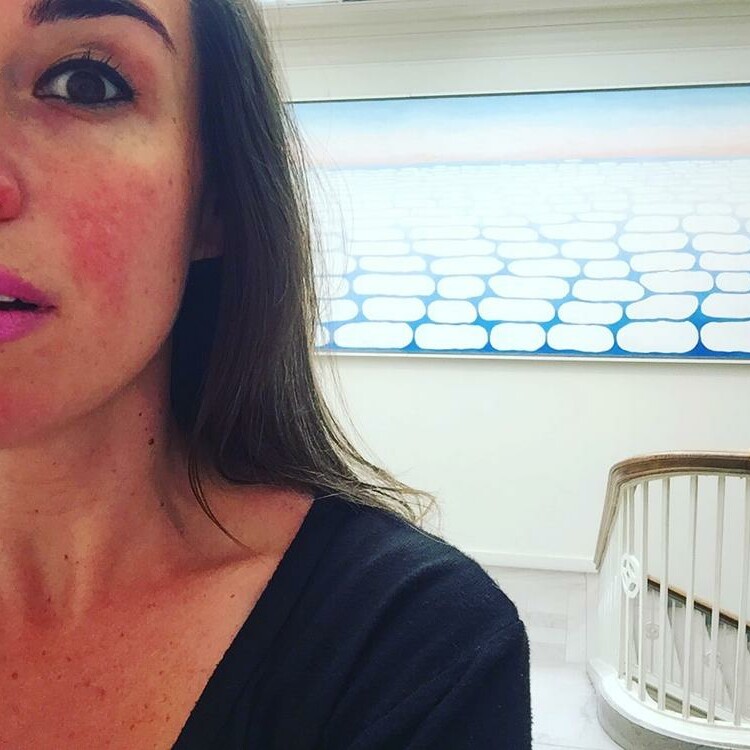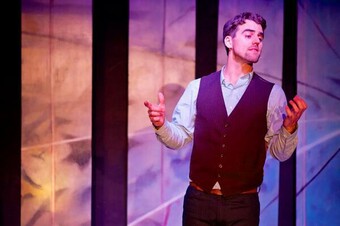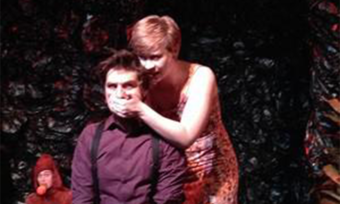Learning About Compassion in A Good Death
On October 5th, I took myself out for a night of theater—Lou Clark’s solo show. “It’s called A Good Death,” I had told my roommates. “And it’s free.”
“Sounds fun,” they grimaced. I left the house alone. Death isn’t fun. That’s, like, the whole schtick with death. It’s death. Faithful to its name, A Good Death is about, well, death, but mainly about how we choose to view it. In particular, the play examines how who might be termed “professionals” of death matters (hospice care workers) strive to make the unthinkable into something good. The show runs about an hour and serves as what I can only describe as informational entertainment.
The playwright/performer Lou Clark is a Communications Ph.D. candidate at Arizona State “specializing in intersections of health and performance in organizations.”
The playwright/performer Lou Clark is a Communications Ph.D. candidate at Arizona State “specializing in intersections of health and performance in organizations.” She explained it to me as a “blend of Performance Studies, Health and Organizational Communication.” The piece looked like a play but at times functioned (and sounded) like a research paper. Clark was continually framing her work—giving checkpoints and reminders to the audience as I remember being taught to do in my college freshman writing seminar. She even introduced herself, which is rare in a solo show. It’s assumed audiences get who you are and that you’re going to tell a story. But, when Clark did it, offering a welcoming, “So, I’m Lou,” it was perfect. “Why doesn’t everyone do this?” I wondered. After all, we introduce ourselves in practically every other instance. Because she’s got lights on her doesn’t mean she has to pretend we’re not just a room of humans.
Speaking of frames, Clark literally began the play inside the doorframe of the theater. Before even entering she told us a little of what we were about to see. She mused about the feeling of “being stuck” and how she had felt that way for thirty years since the surprising death of a loved one in her youth. She ended her opening monologue with a succinct, “This is the story of how I got out” as she finally walked freely into the space.

“This is the story of how I got out”
A Good Death follows Clark from her childhood bereavement to her eventual understanding of death through the passing of her partner’s mother. Clark plays a smorgasbord of characters who help her along her journey toward understanding ranging from her partner Julie to herself as a child and even Frank Sinatra. Perhaps most notably Clark portrayed experts in the field of hospice care. The front page of the program announced that the piece had been “freely adapted” from a dissertation about the importance of compassion in hospice work by Dr. Deborah Way (a former ASU doctoral student in philosophy). But everything always looped around to what we had been promised we’d explore from the start.
“This is a love story,” Clark had told us within the first ten minutes. She explained flat-out, although I had already read it in my program, that some of what we were about to see was research done by Dr. Debbie Way. Again, it was interesting to get these contexts not from an announcement beforehand or an article I may have come across before or after the show, but from within the performance.
Resonating with the straightforward narrative, the production value was simple. The play was performed in a small fiftyish seat black box called The Empty Space Theatre on ASU’s campus. There was one main set piece—a bed—which represented Lou’s childhood bed, various hospice care patients’ living quarters, and finally the deathbed of Lou’s partner’s mother. There was a stool, a doorway, a nightstand. Nothing fancy. We didn’t need much else to string us along. Then, again, I had known the show was going to be academic in tone. I tried to put myself in the shoes of an audience member who hadn’t expected an educational show at the theater.
There was a stool, a doorway, a nightstand. Nothing fancy. We didn’t need much else to string us along.
Would the play have seemed lackluster? I think any way you slice it, the play is interesting and thought-provoking. However, I wondered if more pizzazz would have brought the story and thus educational information to life even more. Or, if the spectacle had played a bigger part in the show, would the educational substance of the piece have gotten swept under the rug? Ultimately, the audience is going to have a theatrical experience, and no one can alchemy the perfect balance of sound cues versus quotes from a dissertation that would impel an audience member to learn. But it’s still a question worth asking.
Similarly, Clark switched into different characters without much ado. She didn’t use costumes or employ wild physical or vocal transformations. When she played a child she held a teddy bear, when she played an older woman with dementia, she had the faintest Southern accent. No frills. In some ways, like the set and the clear-cut script, the plain character choices highlighted the messages of the play. On the other hand, was some of the inherent emotional treasure of discussing death left buried under the tidy acting? Do we miss the razzle dazzle of theater even as we appreciate a play’s clarity of ideas? Perhaps these ideas are not mutually exclusive, but they certainly exist in balance against each other.
After the play ended, director Jen Linde said there wouldn’t be a typical talkback. Instead, she gestured to refreshments and said everyone should feel free to process in whatever way felt natural to them. Upon entering the theater everyone had passed a collection box for Hospice of the Valley and was given a reflective questionnaire. As I eavesdropped on the mingling and chatting people were doing, I filled mine out. I sifted through my experience of watching this woman play her lover’s dying mother in juxtaposition with her portrayal of caring but detached hospice workers. What did I learn? I wondered.
Clark (as Way) had explained the three basic steps to maintaining compassion: recognizing, relating, and responding.
A Good Death gave me the opportunity to organize a lot of thoughts and hearsay I had previously (sorta) known about the business of dying. It dawned on me I had been listening to what it means to be compassionate in a career, how good that makes patients feel, and how much better the world is with compassion…without realizing that Clark had been the nurse for the night, the audience her patients. Halfway through the play, Clark (as Way) had explained the three basic steps to maintaining compassion: recognizing, relating, and responding. The play had the same structure! From the sincere welcome written into the script to the clear message of the text to the straightforward design of the piece, I was treated as a living person instead of a fourth wall. I wasn’t dying, but I appreciated the compassion. In the end, I think that was Clark’s point. Don’t treat the dying as dead.
I truly wonder how this play would stand if it were to be done with more artistic flair. Initially, I pondered if the straightforward, almost persuasive essay-type language and bare bones production could shut people out of the monologues. Now I see the play’s acts of compassion, may require a certain kind of simplicity, perhaps more important than aesthetics. A hospice care center can be beautiful, but if the health care provider can’t simply connect with her patient, not much else matters. At one point in the play, a care-giver named Charlene explains that compassion means, “giving all you’ve got to someone and making them feel special.” By that definition, A Good Death was not just about compassion, but was.






Comments
The article is just the start of the conversation—we want to know what you think about this subject, too! HowlRound is a space for knowledge-sharing, and we welcome spirited, thoughtful, and on-topic dialogue. Find our full comments policy here